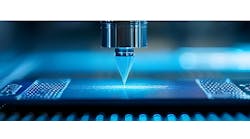Nearly every company that uses automated machines has had to deal with the prospect of finding a replacement part to keep the machine running. Typically, during one or more of those searches for the part that keeps the machine working, they have found a roadblock in the form of terms such as unavailable, discontinued or some version of long lead time. Those words inspire people to begin the search for a different part or component that is similar enough to the original so it will get the machine back up and running. As a supplier, we would refer to this as “doing a crossover” or “finding a cross.”
Many components lend themselves to crossing from one manufacturer to another or from one product in a manufacturer’s product family to another. A pressure gauge, for instance, might be easily crossed by matching the gauge type, thread type and pressure range. It might look different but fits in the same place and performs the same function. An electronic sensor is not so easy. While the technology employed might be similar, physical, electrical and operational characteristics are probably different enough to prevent a sensor from one manufacturer being a drop-in, or form, fit and function replacement for one from another manufacturer.
It will typically require some effort from the customer, such as machine-controller program changes, custom-mounting brackets or wiring changes. Therefore, in general, it's much harder to cross an automation control component.
It’s good to understand this from the perspective of the usual players in the crossover hunt game. The machine user, the machine builder and the supplier—often a distributor with access to multiple product lines—each has a unique need and a unique perspective on the problem.
Machine builders
Machine builders design, build and deliver the machine to the machine user. As such, they start with a desired goal for the machine, such as loading pills in a bottle, maintaining level in a tank or cleaning semiconductor wafers and putting them in a cassette.
During design time, products are selected to best meet the needs for accomplishing that goal. Parts are purchased and used during the building of the machine. If, during that build process, one of the parts can’t be procured, the machine builder generally has the flexibility, knowledge and ability to switch to an available crossover without too much of a problem.
Brackets can be modified, and documents and wiring diagrams can be changed before shipping so the end user gets accurate documentation. It’s not ideal, but it works fairly easily.
Machine user
The end user has different challenges. There’s often a tremendous amount of pressure to get a broken machine working again. That flexibility, knowledge and ability to modify the machine to use a different part or to modify the part to fit the machine is not usually available at the customer like it is at the machine builder.
Another element that makes the process harder is that the end user may not be able to tell the supplier exactly how the part is used or which features are the most important and which can be ignored.
We’ve worked on crossovers where the machine came with a very flexible photoelectric sensor with tons of features and configurability so that it could work in many applications. If the customer could have told us exactly what features were being used, it would have been easier to find a sensor to meet those needs, but the sensor was so unique in its abilities that we couldn’t find anything close to matching it. They didn’t know how it was used; they only had a part number.
Finally, if you are a large manufacturer who has multiples of the same model of a machine, it can really make it difficult for the maintenance department. If parts were swapped out with ones that are different than those on the drawings and in the documentation, each machine is now slightly different.
Supplier
The supplier is often called upon to help cross a part with no context. The request often takes the form of “Please quote part number X or its equivalent.” For some parts, as in the gauge mentioned previously, it may be as easy as going to a different manufacturer’s documentation and using a cross-reference document they’ve created.
But, for most automation controls products, like electronic sensors, programmable logic controllers (PLCs), human-machine interfaces (HMIs) and motors, it gets much more complicated and requires more information. The basic questions of who, why, and what need to be answered.
Who is making the request? Does the requestor have the authority to substitute parts on the machine? We have encountered many requests where the requestor is a purchasing agent or another person not intimately familiar with the machine or the part.
They are trying to be resourceful or helpful and undertake to find a replacement part, but they don’t have the authority to specify the new part for use in the machine. Thus, when they bring the crossover part number to maintenance or engineering, it’s rejected.
The issue of why is often overlooked. Reasons a company end user or machine builder might be on the hunt for a crossover could be that they are unhappy with the supplier of their current part. They could also have a machine down and are desperately trying to get it working again.
It could be that they feel that the part is too expensive. Finally, it’s common practice for procurement departments to look for a second source for the part. The second source is well-intentioned planning for just the situation we’ve been talking about where a required original part is unavailable or has a long lead time.
We’ve worked on hundreds of crossover requests. We’ve talked to other suppliers about their efforts, and the consensus is that they may provide a sales development opportunity, but they rarely present the opportunity for making a transactional sale after doing the work to find a fairly suitable part because we didn’t understand the why.
The hardest to overcome is when there is an immediate, urgent need because of a machine-down situation for an end user. They usually end up finding the part they need from a surplus house or figure out some way to make the machine work until a suitable exact matching part can be found.
Knowing and understanding the application for the part—the what—is crucial in performing a crossover. Most automation control products have flexibility built in so that they can fit into many applications. Having many features also makes the spec sheet for the product more enticing. However, since each manufacturer may choose to focus on different features from their competitors, it becomes very difficult to match similarly performing products from Manufacturer A to one from Manufacturer B.
Consider a temperature controller, for example. If a customer is calling to request an advanced controller with the ability to have heater burnout alarms and Modbus communications but isn’t using those features, then there’s no need to find a replacement that does have those. Essentially, knowing the what opens up the possibilities for more products to fit in the application.
Imagine being asked to find a replacement for a screwdriver. However, the screwdriver has multiple sizes of Phillips, flat head and hex bits in its handle that can be inserted into its shaft. If all you have are standard screwdrivers without interchangeable bits, you wouldn’t know which kind of screwdriver to bring the person. So, you may spend extra time looking for screwdrivers to match every bit, but the person really just wanted the flat head variety.
A sensor example
For example, a machine user might indicate it is looking for replacement of Sensor A from Manufacturer A. A simple web search of the part number yields the specification sheet.
An application engineer reviewing the spec sheet finds that the terminology doesn’t line up with that used by the manufacturer with which he’s familiar. For example, instead of describing it as a retro-reflective sensor, common terminology in the industry, it’s described as a photoelectric reflex switch. This terminology could be a barrier to proceeding for newer, less experienced application engineers. But, in this case, it’s determined that the key features of the sensor are retroreflective, light-on, 24 Vdc NPN with a sensing range of 200 mm.
Manufacturer B has several options for sensors with this basic specification—sensors that will perform the same basic function. However, Sensor A has a particular physical shape, and the mounting hardware is unique to that shape. Any sensor from Manufacturer B that has similar functionality has a different shape and mounting. To use Sensor B would require finding a way to essentially mount a square peg in a round hole.
However, if the supplier understands the crossover process better and learns whether they are dealing with an end user or machine builder and knows the who, why and what of the application, then this could turn into an opportunity.
Crossover requests are a common part of customer and supplier duties. Both customers and suppliers can help themselves in the process if they understand whether the requestor is a machine builder or end user, and if the who, why and what are clearly understood.
Ray Marquiss is senior application engineer at Valin, a subsidiary of Graybar. Contact him at [email protected].
Corey Foster, MID, is the director of automation sales & application engineering at Valin, a provider of automation for the technology, energy, life sciences, natural resources and transportation industries. Contact him at [email protected].

Leaders relevant to this article:





